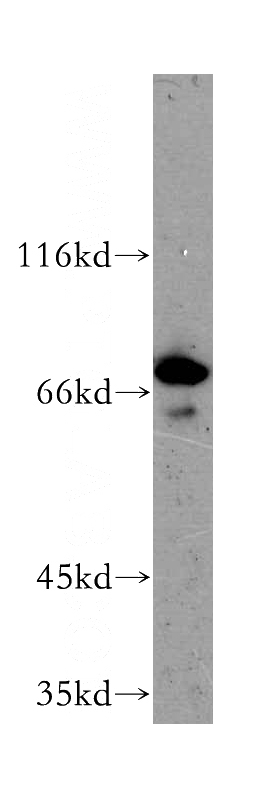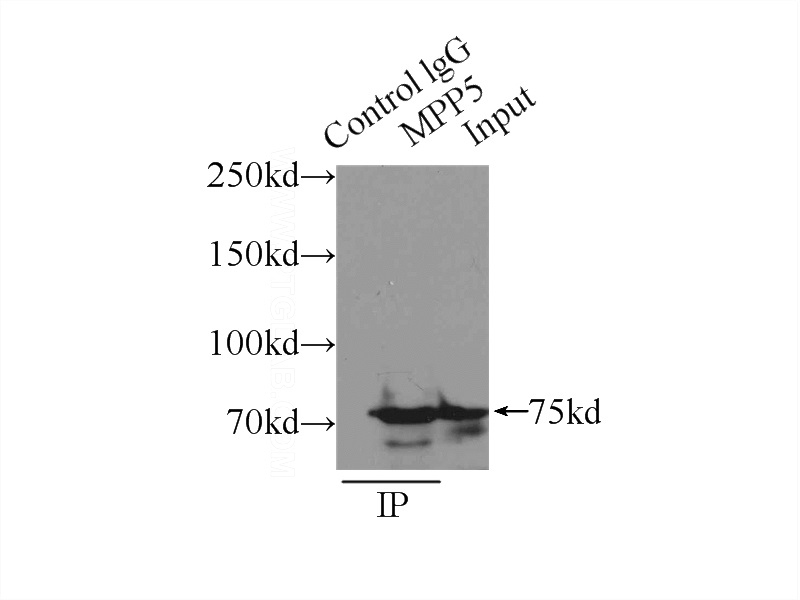-
Product Name
MPP5 antibody
- Documents
-
Description
MPP5 Rabbit Polyclonal antibody. Positive IP detected in mouse brain tissue. Positive WB detected in Y79 cells, human brain tissue. Observed molecular weight by Western-blot: 70-75kd
-
Tested applications
ELISA, WB, IP
-
Species reactivity
Human,Mouse,Rat; other species not tested.
-
Alternative names
FLJ12615 antibody; MAGUK p55 subfamily member 5 antibody; MPP5 antibody; PALS1 antibody
-
Isotype
Rabbit IgG
-
Preparation
This antibody was obtained by immunization of MPP5 recombinant protein (Accession Number: XM_047431691). Purification method: Antigen affinity purified.
-
Clonality
Polyclonal
-
Formulation
PBS with 0.02% sodium azide and 50% glycerol pH 7.3.
-
Storage instructions
Store at -20℃. DO NOT ALIQUOT
-
Applications
Recommended Dilution:
WB: 1:500-1:5000
IP: 1:500-1:5000
-
Validations

Y79 cells were subjected to SDS PAGE followed by western blot with Catalog No:112749(MPP5 antibody) at dilution of 1:400

IP Result of anti-PALS1 (IP:Catalog No:112749, 3ug; Detection:Catalog No:112749 1:1000) with mouse brain tissue lysate 8000ug.
-
Background
MPP5, also named as PALS1, belongs to the MAGUK family which interact with the cytoskeleton and regulate cell proliferation, signaling pathways, and intracellular junctions. MPP5 is thought to organize intracellular PALS1-CRB-MUPP1 protein scaffolds in the retina that are involved in maintenance of photoreceptor–Mu¨ller glia cell adhesion. MPP5 plays a role in tight junctions biogenesis and in the establishment of cell polarity in epithelial cells.
-
References
- Park B, Alves CH, Lundvig DM. PALS1 is essential for retinal pigment epithelium structure and neural retina stratification. The Journal of neuroscience : the official journal of the Society for Neuroscience. 31(47):17230-41. 2011.
- Alves CH, Sanz AS, Park B. Loss of CRB2 in the mouse retina mimics human retinitis pigmentosa due to mutations in the CRB1 gene. Human molecular genetics. 22(1):35-50. 2013.
- Dudok JJ, Sanz AS, Lundvig DM, Wijnholds J. MPP3 is required for maintenance of the apical junctional complex, neuronal migration, and stratification in the developing cortex. The Journal of neuroscience : the official journal of the Society for Neuroscience. 33(19):8518-27. 2013.
- Dudok JJ, Sanz AS, Lundvig DM. MPP3 regulates levels of PALS1 and adhesion between photoreceptors and Müller cells. Glia. 61(10):1629-44. 2013.
- Kanda A, Noda K, Yuki K. Atp6ap2/(pro)renin receptor interacts with Par3 as a cell polarity determinant required for laminar formation during retinal development in mice. The Journal of neuroscience : the official journal of the Society for Neuroscience. 33(49):19341-51. 2013.
- Alves CH, Bossers K, Vos RM. Microarray and morphological analysis of early postnatal CRB2 mutant retinas on a pure C57BL/6J genetic background. PloS one. 8(12):e82532. 2013.
- Pellissier LP, Alves CH, Quinn PM. Targeted ablation of CRB1 and CRB2 in retinal progenitor cells mimics Leber congenital amaurosis. PLoS genetics. 9(12):e1003976. 2013.
- Dudok JJ, Murtaza M, Henrique Alves C, Rashbass P, Wijnholds J. Crumbs 2 prevents cortical abnormalities in mouse dorsal telencephalon. Neuroscience research. 2016.
Related Products / Services
Please note: All products are "FOR RESEARCH USE ONLY AND ARE NOT INTENDED FOR DIAGNOSTIC OR THERAPEUTIC USE"
